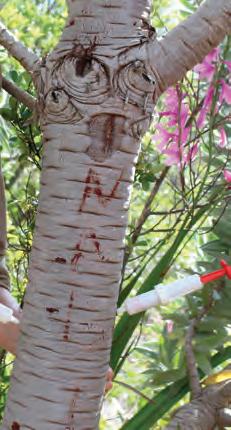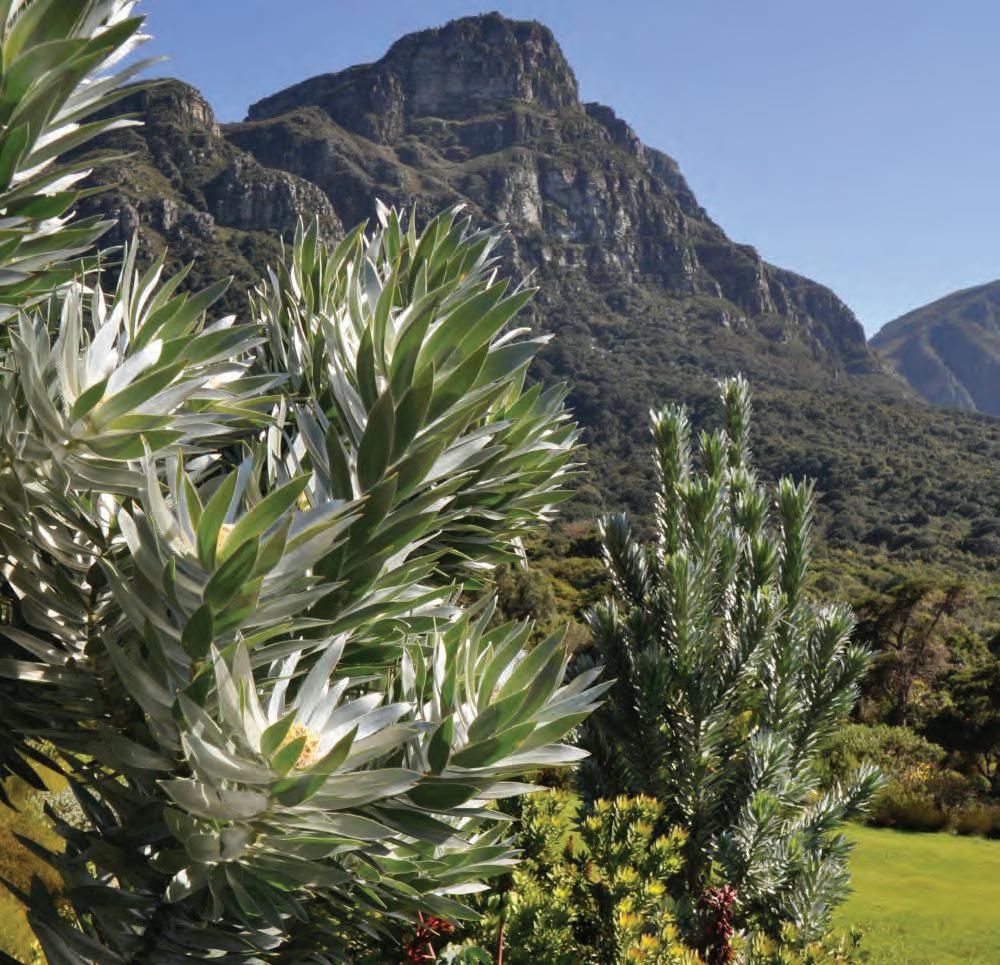
3 minute read
Kirstenbosch strives to save endangered Silver Tree
Kirstenbosch Strives to Save Rare and Endangered Silver Tree
Kirstenbosch National Botanical Garden of our garden beds is infested with this in Cape Town, in collaboration with the devastating organism, which is why many of Botanical Society of South Africa, Table the Silver Trees in Kirstenbosch are dying.” Mountain National Park (TMNP), FABI (Forestry and Agricultural Biotechnology In a bid to save the Silver Trees, Institute) and the South African National Kirstenbosch, in collaboration with FABI, Biodiversity Institute (SANBI), has launched have launched a phosphite treatment an innovative project to save an endangered trial. “We are testing the application tree which only occurs naturally in a tiny of a biodegradable fungicide known as area of the Cape Peninsula. phosphite, which can protect plants against Phytophthora die-back. Phosphite will not The Silver Tree (Leucadendron argenteum), eradicate Phytophthora from the soil, but also known as the Silver Leaf Tree, it can protect plants from infection, and Witteboom, or Silwerboom, is a protected can help them recover if they are already evergreen tree which is part of the Protea infected,” explains Dr Paap. “We have family. This enormous silver Protea is sprayed some of the Silver Tree seedlings naturally confined to a tiny area in and and injected bigger trees with phosphite. around the city of Cape Town – with its We have also left other plants untreated, main population growing on the slopes as controls, and are monitoring the survival of Table Mountain, notably the Lion’s rates of the treated and non-treated trees.” Head area, above Rhodes Memorial and the mountain slopes above Kirstenbosch Phosphite is used in South African National Botanical Garden. agriculture and horticulture settings to guard against Phytophthora root and crown Historically, the Silver Tree was widespread rot of several important commercial crops. on Table Mountain, covering much of its slopes in shimmering silver forests. However, it has never been applied to However, early demand for timber led to indigenous South African flora. “The team is much of these forests being felled and now incredibly excited about the first use of this the Silver Tree is a rare and threatened treatment on indigenous South African flora species - in danger of becoming extinct and are optimistic that the trials will confirm in the wild in the next 50 years if we the suitability of phosphite application as a do not take care of the remaining wild means to protect this iconic tree species,” populations. says Dr Trudy Paap from FABI (Forestry And Agricultural Biotechnology Institute). “Not only do we hope to find an effective treatment against Phytophthora in order to save the Silver Tree population in Kirstenbosch, but we also have the objective of restoring 8000 Silver Trees to sites where historically they occurred naturally.”
Advertisement
Unfortunately, this rare tree is susceptible to infection from a fungus called Phytophthora cinnamomi, a soilborne pathogen that causes root and collar rot. Phytophthora feeds on living plant roots and stems, reducing the plants’ ability to transport water and nutrients – often leading to the death of the host. Dr Trudy Paap, Dr Mesif Gosa from FABI, Mashudu Nndanduleni and Mpendulo Gabayi, the conservation horticulturists at Kirstenbosch National Botanical Garden explain that this devastating introduced pathogen is present in wild Silver Trees as well as in the population found in Kirstenbosch National Botanical Garden, where it is causing the death of many of these trees. “Unfortunately, the soil in some Visitors to Kirstenbosch may notice marked trees. This is to assist with the monitoring of the project and people are urged not to remove these tags. Kirstenbosch are also calling on the public to stay out of the plant beds as the microscopic spores of Phytophthora are easily spread on the bottom of shoes.
Kirstenbosch National Botanical Garden forms part of a network of exceptional National Botanical and Zoological Gardens



that exist across the country which are managed by the South African National Biodiversity Institute (SANBI). “SANBI’s overall mandate is ‘To explore, reveal, celebrate, and champion biodiversity for the benefit and enjoyment of all South Africans’. To this end, conservation projects such as this one, which plays an integral part in the protection and survival of indigenous trees, are essential,” concludes Gabayi. For more information on the conservation efforts and unique species found at Kirstenbosch visit:










